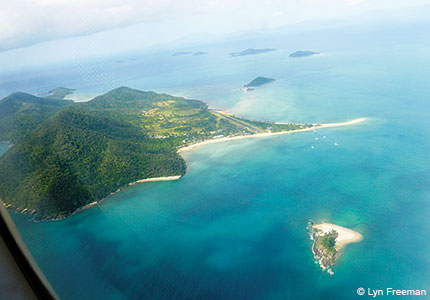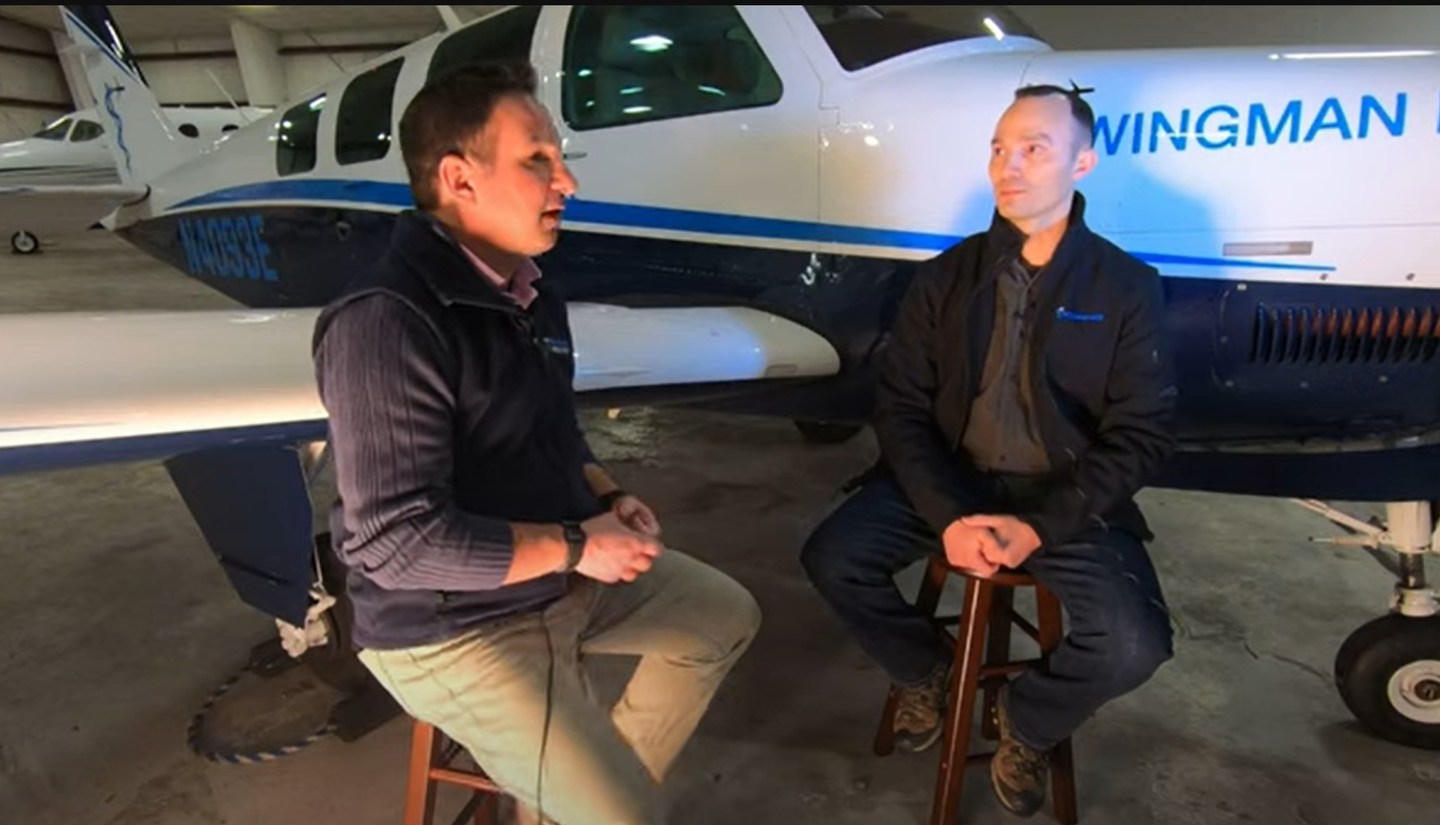Memories Of Australia
Imagine a 2,200-mile-wide desert island with magnificent cities built on the coasts. That’s Australia.
 Dunk Island, Great Barrier Reef |
Flying down from Guadalcanal in the Solomon Islands, your course line slowly merges with Australia's east coast as you sneak in from the left. The angle is so slight, you may not even notice the land of Oz until you're practically feet dry.
The country seems to simply materialize in the stark beauty of the Coral Sea. If your destination is Brisbane, you'll spot the coast from two hours out, as the ocean below becomes shallower and begins to justify its name.
NASA tells us the Great Barrier Reef is the Earth's largest living feature that may be seen from space, and you begin to understand the enormity of the reef as you look down at the menagerie of color below. The 1,200 nm reef runs along most of the country's east coast, a scuba diver's paradise if you ignore the occasional shark or sea snake.
On my first trip Down Under (do Aussies call the rest of the world Up Over?) in 1992, I made landfall at Cairns, far up on the northeast corner of the country, a lush, tropical paradise a mere 17 degrees south latitude from the equator, about the same distance south as San Juan, PR, is north.
Cairns is one of Australia's most beautiful cities, fronted by the Western Pacific and backed by the Great Dividing Range of mountains. For much of the year, Cairns luxuriates in warm weather and sunshine, with occasional light rain and puffy clouds.
I was flying a Cessna Skymaster on that first, 7,500 nm trip, and after a comfortable overnight in downtown Cairns, I fired up early the next morning and prepared to launch for my final destination of Perth, diagonally across the country. It would be hard to find two locations in Australia more distant than Cairns and Perth.
When the controller asked my destination on my "no details" flight plan, and I told him Perth, there was a short pause; then, "What stops are you planning for fuel?"
"None," I said.
Another longer pause, then, "Sir, are you aware of the distance from Cairns to Perth?"
"Yes sir," I replied. "The Garmin says 1,860 nautical miles."
He keyed the mic once more, and I heard conversation in the background. Short pause, then, "Oh yes, you're the American ferry flight that came in from the Solomons last night. Okay, you're cleared to taxi to the holding point for runway!"
Once in the air, I urged the Skymaster just high enough to clear the Great Dividing Range and pointed the nose southwest toward Alice Springs and Uluru, better known as Ayers Rock, close to the center of the country. After I had passed the coastal mountains, I descended to roughly 500 feet above the terrain and settled in for the 14-hour flight.
The vast majority of Australia's population lives on the coasts of the country in major cities such as Canberra, Cairns, Townsville, Brisbane, Sydney, Melbourne, Adelaide, Perth and Darwin. As mentioned above, the only significant city in the interior is Alice Springs, population 26,000, isolated from the coasts by 500 to 1,000 nm of desert in all directions.
As the miles slid by, little changed below the airplane. The Australian Outback could easily pass for the American Southwest except for the lack of mountains and the dominance of termite mounds---millions of them. Occasionally, I noticed the tan/brown earth interrupted by surges of life---kangaroos flowing across the outback, bouncing sporadically in every direction.
There was little to slow them down. Nature abhors straight lines and symmetry, and you won't find much of either in the outback. There are few roads---paved, dirt or any other kind---minimum power lines and only sporadic railroad tracks.
Even more significant, there are few fences---a standard signpost to even lightly populated spaces. In much of the rest of the world, fences are a giveaway to the presence of man. Roads, power lines, railroad tracks and fences often follow straight lines, and in much of the outback, there's simply no need for straight lines. You can fly for a half hour or more without spotting even the slightest manifestation of humans.
The "stations" (ranches in U.S. speak) are huge by comparison to their American counterparts. The outback is so arid, it requires large expanses of grazing land to feed cattle or sheep. Here in the U.S., the largest ranch covers just under a million acres. In Australia, million-acre stations are common, and the biggest of all covers six million acres, roughly the size of the state of Maryland.
With such enormous areas to patrol, many owners of stations police them by aircraft, either fixed wing or helicopter. Don't plan on seeing many in the interior of Australia, however. The country is so large, it swallows up literally thousands of stations of all shapes and sizes.
One of the great attractions of Australia is Ayers Rock, 210 nm southwest of Alice Springs. I pulled up to 3,000 feet crossing Alice Springs, then veered slightly left to head for Uluru. The large sandstone rock formation stands alone, about 1,000 feet tall, and if you think there couldn't possibly be any traffic here in the middle of Australia, you'd think wrong.
I set up a left orbit of the rock formation about 1,000 feet above the crest, only to spot a 737 coming the other way around at the same altitude. At the time, there was airline service from Sydney or Melbourne that provided flightseeing tours of Uluru. I turned away to let the big guy cruise by in a 20-degree bank. When he finished his first circle, he reversed direction and flew a tight 360 in the opposite direction, presumably to allow passengers on both sides of the airplane to see and photograph this famous Australian landmark.
With my flight just under half over, I turned back on course and continued southwest toward Perth, another 1,100 nm. West of Alice Springs, Australia, becomes a haven for mining, especially gold mining. In fact, the Skymaster's owner, Blair Howe, had been a hard rock miner for 30 years until the day he swung his pick for the millionth time, and there it was. Howe had finally hit a major vein of gold and struck it rich.
He sold his claim to a major mining company and went into the business of transporting people and equipment around the Great Sandy Desert near Mt. Magnet in Western Australia.
When I finally handed him the Skymaster's keys the following day, I asked about the problem of prop strikes on the rear propeller from rocks and debris kicked up by the front prop. Cessna had anticipated the possibility of over-rotation and had mounted the rear engine with a thrust line six inches higher than that of the front engine. Still, I wondered about damage to the rear prop during operation on rocky or dirt strips.
He smiled and opened the door to a storage shed directly behind the airplane's parking spot, and there stood four shiny, new propellers strapped against the wall, wrapped in plastic, ready for service.

Subscribe to Our Newsletter
Get the latest Plane & Pilot Magazine stories delivered directly to your inbox






